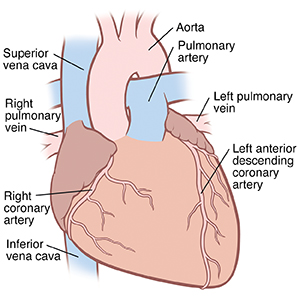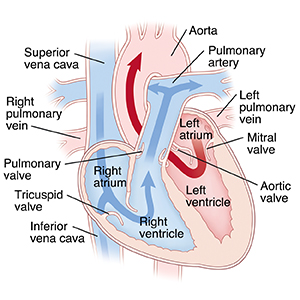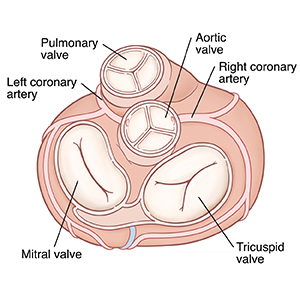A
B
C
D
E
F
G
H
I
J
K
L
M
N
O
P
Q
R
S
T
U
V
W
X
Y
Z
Click a letter to see a list of conditions beginning with that letter.
Click 'Topic Index' to return to the index for the current topic.
Click 'Library Index' to return to the listing of all topics.
How the Heart Works
The heart pumps blood to the brain, lungs, and body. A heart that works well is needed for good health and to sustain life. To understand heart problems better, it may help to learn how a healthy heart works.
The heart muscle
The heart muscle squeezes (contracts) to pump blood. When it relaxes, it refills with blood. To do its work, the heart muscle needs a constant supply of oxygen. Oxygen is supplied to the heart muscle by blood vessels that wrap around the surface of the heart. They include:
-
The left main coronary artery. This branches into the:
-
The right coronary artery. This supplies blood to the bottom, right side, and back of the heart muscle.

Inside the heart
The inside of the heart is divided into right and left sides. Each side has an upper chamber and a lower chamber. The upper chamber is called the atrium. The lower chamber is called the ventricle. The right atrium relaxes and fills with blood from the body. When it contracts, it pumps blood to the right ventricle. The right ventricle then pumps blood to the lungs. The blood picks up oxygen in the lungs. The left atrium then fills with oxygen-rich blood from the lungs. It pumps this blood to the left ventricle. From there, the blood is pumped to the brain, coronary arteries, and the rest of the body.
Valves control the flow of blood. There are four valves in the heart. When the heart beats, valves act like one-way doors. This keeps blood moving forward through the heart and into the body and lungs.
The cycle continues. The right side of the heart pumps oxygen-poor blood from the body to the lungs, where it gets oxygen again. The left side of the heart pumps oxygen-rich blood from the lungs to the body. Once the body’s organs and tissues have removed the oxygen from the blood, the blood returns to the heart. The cycle is then repeated.

 |
| Top view of the normal heart showing the coronary arteries and four valves. |
Parts of the heart
-
Superior vena cava. This carries oxygen-poor blood from the upper part of the body to the right atrium.
-
Inferior vena cava. This carries oxygen-poor blood from the lower part of the body to the right atrium.
-
Right atrium. This gets oxygen-poor blood from the body through the superior vena cava and the inferior vena cava and pumps the blood to the right ventricle.
-
Tricuspid valve. This lets oxygen-poor blood flow forward from the right atrium to the right ventricle.
-
Right ventricle. This pumps oxygen-poor blood through the pulmonary valve.
-
Pulmonary valve. This lets oxygen-poor blood flow forward to the pulmonary artery.
-
Pulmonary artery. This carries oxygen-poor blood to the lungs to get oxygen.
-
Pulmonary veins. These carry oxygen-rich blood from the lungs to the left atrium.
-
Left atrium. This gets oxygen-rich blood from the lungs through the pulmonary veins and pumps the blood to the left ventricle.
-
Mitral valve. This lets oxygen-rich blood flow forward from the left atrium to the left ventricle.
-
Left ventricle. This pumps oxygen-rich blood through the aortic valve.
-
Aortic valve. This lets oxygen-rich blood flow forward to the aorta.
-
Aorta. This carries oxygen-rich blood to the rest of the body.
Online Medical Reviewer:
Heather M Trevino BSN RNC
Online Medical Reviewer:
Jessica Gotwals RN BSN MPH
Online Medical Reviewer:
Stacey Wojcik MBA BSN RN
Date Last Reviewed:
12/1/2024
© 2000-2025 The StayWell Company, LLC. All rights reserved. This information is not intended as a substitute for professional medical care. Always follow your healthcare professional's instructions.